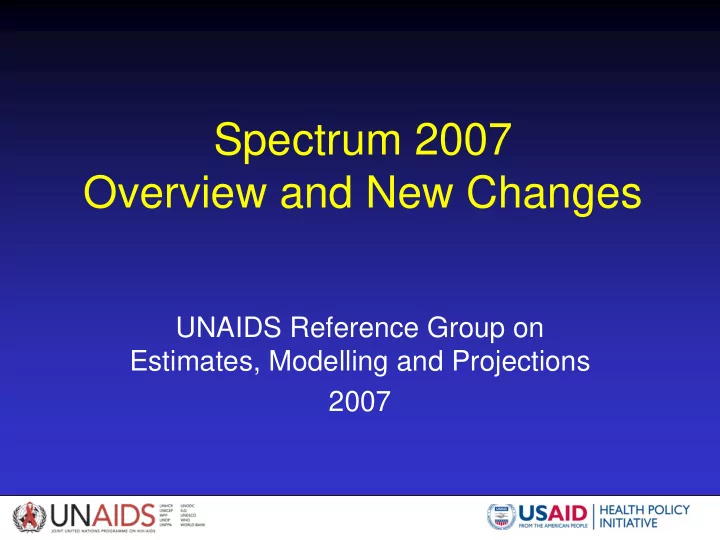

Spectrum 2007 Overview and New Changes UNAIDS Reference Group on Estimates, Modelling and Projections 2007
Purpose • Determine the consequences of the prevalence estimates made with EPP or Workbook – New infections, HIV+ population, AIDS deaths – Need for treatment and effects of treatment – Orphans
New Features 1. New treatment options Adults: 1 st and 2 nd line ART • • Children: ART and co-trimoxazole 2. Updated progression periods • New infection to need for treatment • Need for treatment to AIDS death w/wo treatment 3. Expanded PMTCT options 4. Calibrate to multiple national surveys 5. Uncertainty analysis
Inputs required Country data Epidemic patterns • Demographic data • Effect of HIV on fertility • Adult prevalence • Progression from infection to need for treatment and to ------------------------- AIDS death • MTCT program • Sex ratio of prevalence description • Age distribution of infection • PMTCT coverage • Mother-to-child transmission • Adult ART coverage rates by regimen and • Child treatment feeding options coverage • Effect of child treatment
Creating a new projection
Population Projection
Population Projection
Population Projection T he fir st ye a r of the pr oje c tion must be be for e the sta r t of the AIDS e pide mic , usua lly 1980
Population Projection T he la st ye a r of the pr oje c tion c a n be a nything up to 50 ye a rs, but it is be st to ma tc h the pre va le nc e e stima te (2012 for E PP, 2007 for the Workbook)
Population Projection
Population Projection
Population Projection Cr e a te s a pr oje c tion using the UN Popula tion Division’s Wor ld Population Pr ospe c ts
Entering data
Selecting inputs to edit
Adult HIV Prevalence
Adult HIV Prevalence
Documenting sources
Effect of HIV on fertility
Effect of HIV on fertility 15- 19: 50% inc re a se 20- 49: 30% de c re a se T F R of HIV- a djuste d to le a ve popula tion T F R unc ha ng e d
Age and Sex Ratio of HIV Prevalence
Ratio of prevalence at each age group to prevalence at 25-29 : Females 1.4 15-19 1.2 20-24 25-29 1.0 30-34 0.8 35-39 40-44 0.6 45-49 0.4 50-54 0.2 55-59 60-64 0.0 65 + 1980 1985 1990 1995 2000 2005 2010
Ratio of prevalence at each age group to prevalence at 25-29 : Males 1.4 15-19 1.2 20-24 1.0 25-29 30-34 0.8 35-39 0.6 40-44 45-49 0.4 50-54 0.2 55-59 0.0 1980 1985 1990 1995 2000 2005 2010
Age and Sex Ratio of HIV Prevalence
Sex ratio of HIV prevalence
Sex ratio of HIV prevalence
Ratio of Female to Male HIV Prevalence 2.5 Senegal DHS Guinea DHS Cote d'Ivoire DHS Ethiopia DHS 2.0 Kenya DHS Ghana DHS South Africa HSRC Cameroon DHS Mali DHS Rwanda DHS 1.5 Uganda 2004-05 Zambia DHS Uganda 88 Zim Malawi 2004 Tanzania DHS Rwanda 86 Masaka 89-97 Lesotho DHS 1.0 Burkina Faso DHS DR DHS Kapiri Mposhi 98 0.5 0.0 0 5 10 15 20 25 Years Since the Start of the Epidemic
Progression from HIV Infection to AIDS Death (Adults) New HIV Infection Normal M 7.5yrs/F 8.5yrs, fast 6.1/6.9 Need for Treatment First Line ART 3 years 15% FY / 5% SY Need for 2 nd Line AIDS Death 15%/5% Second Line ART
Progression from HIV Infection to AIDS Death (Children) New HIV Infection Need for Treatment Age-dependent AIDS Death First Line ART Age-dependent
Adult Male Progression without Treatment 100 80 60 40 Need Treatment Dead 20 0 0 2 4 6 8 10 12 14 16 18 20 Years Since I nfection
Projections of Adult ART Coverage 100 90 80 70 60 50 40 30 20 10 0 2000 2002 2004 2006 2008 2010 2012 Linear Trend Unmet Need % Target Unmet Need Trend
Orphans % women 15-19 never married: 38%-94% (71%) % married women in monogamous union: 45%-96% (71%)
Spectrum outputs
Various displays are available
Comparing effects • Display up to four projections at one time • Open same projection twice and rename to create comparison scenarios
Plausibility Bounds
Plausibility Bounds • Uncertainty around prevalence curve – EPP: read sampled curve from EPP .spu file – Workbook: generate 1000 logistic curve fits by varying annual estimates according to data quality
Logistic Curve Fits to Annual Estimates 2.0% 1.8% 1.6% 1.4% 1.2% 1.0% 0.8% 0.6% 0.4% 0.2% 0.0% 1980 1985 1990 1995 2000 2005 2010
Logistic Curve Fits to Annual Estimates with 95% Plausibility Bounds 2.0% 1.8% 1.6% 1.4% 1.2% 1.0% 0.8% 0.6% 0.4% 0.2% 0.0% 1980 1985 1990 1995 2000 2005 2010
If you use the Workbook you need to generate prevalence curves
After generating prevalence curves from Workbook estimates process the uncertainty analysis
Exercise • Create a new demographic projection using EasyProj • Read prevalence estimate from EPP or Projections Workbook • Select appropriate patterns for Progression and Age/Sex Ratios • Add data on coverage of PMTCT, ART and child treatment programs • Review key indicators • Do uncertainty analysis
Recommend
More recommend